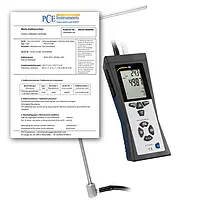
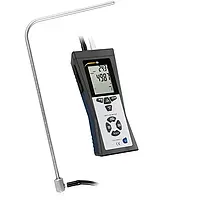
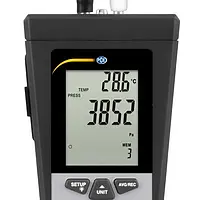
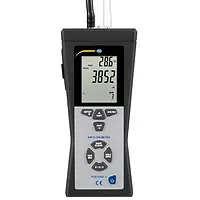
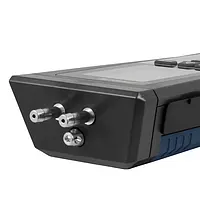
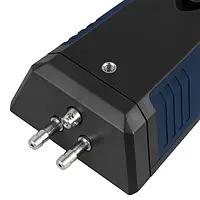

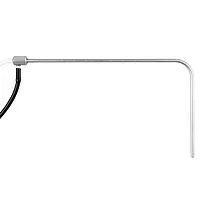
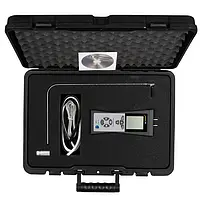
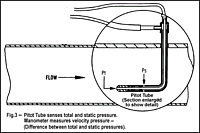
Bilingual Technical Support (EN / ES)
Public Service, Military and First Responder Discount
30 Day Return Policy
2 Year Warranty
PCE-HVAC 2 Pitot Tube Anemometer incl. ISO Calibration Certificate
Measures air velocities up to 80 m/s (178.66 mph) / Zero, minimum, maximum, average, record and hold functions / Stores to memory up to 99 measurement values per parameter
PCE-HVAC 2 is a pitot tube anemometer used to determine air velocity, air pressure, airflow, differential pressure and ambient temperature. The pitot tube anemometer allows access through tiny openings to take measurements in small pipe systems and other confined spaces.
Stored measurement values can be recalled on the device itself or on a computer. Data transfer to a computer is completed quickly and easily using a USB port. Real-time measurement values also can be displayed on a computer using a USB connection and the downloadable PC-compatible software (see downloads tab for details). In addition to an ergonomic design, the pitot tube anemometer boasts a backlit display that allows for use in low-light conditions. The PCE-HVAC 2 high-velocity pitot tube anemometer has a thread on the bottom, so the device can be mounted on a tripod. The measuring hoses are inserted at the top of the device to connect the pitot tube.
The PCE-HVAC 2 anemometer with Pitot tube is a heavy-duty measuring device designed for use in harsh conditions, including high airflow velocity and high temperature applications. The PCE-HVAC 2 Pitot tube anemometer's robust design and use of the principles of static and dynamic pressure make the device ideal for use in testing, adjusting and balancing HVAC systems, providing easy access through narrow ducts and pipes. The device also is used in the testing and inspection of aircraft, race cars and industrial machines.
During the measurement process, the Pitot tube is inserted into the middle of the airflow, with the opening of the tip facing the flow of the air. This allows the measuring device to capture even the smallest fluctuations in airflow velocity. The anemometer connected to the Pitot tube recalculates the obtained velocity pressure values into flow velocity. It is especially recommended for high and mid-range velocities. Two weak points of Pitot tube anemometers are: they do not perform their function properly at very slow flow velocity and are extremely sensitive to turbulence. Nevertheless, installed correctly (avoiding any sources of turbulence), they are capable of measuring, for example, inside the ducts and providing good results. If it happens that the duct is not straight, or a pipe consists of a few sections, the correct insertion of the Pitot tube is required, since at different points of the pipe (in the middle, near the walls and at the intersection of the pipes), the average velocity changes, and the device must be preferably located at that part, the flow in which is the closest to the average velocity value. The measurement units in the Pitot tube anemometer, calibrated for air flow measurements, should be corresponding to flow velocity.
Calibration certificates are issued specifically for the customer and are excluded from the right of return.
| Air pressure | |
| Accuracy | ± 0.3% of reading at 25°C / 77°F |
| Repeatability | ± 0.2% (± 0.5% of reading) |
| Linearity / hysteresis | ± 0.29% of reading |
| Pressure range | 5000 Pa |
| Maximum pressure | 10 psi |
| Response time | Typically 0.5 seconds |
| Measuring range |
0.7252 psi 50.00 mbar 20.07 inH2O 509.8 mmH2O 5000 Pa |
| Resolution |
0.0001 psi 0.01 mbar 0.01 inH2O 0.1 mmH2O 1 Pa |
| Selectable units | Mbar, psi, inH2O, mmH2O, or Pa |
| Air speed | |
| Measuring range |
1 ... 80 m / s 200 ... 15733 ft / min 3.6 ... 288 km / h 2.24 ... 178.66 MPH 2 ... 154.6 knots |
| Resolution |
0.01 m / s 1 ft / min 0.1 km / h 0.01 MPH 0.1 knots |
| Accuracy |
At m / s: ± 2.5% of measured value At ft / min, Km / h, MPH and Node: Depending on the air speed and the size of the air duct |
| Flow rate | |
| Measuring range |
0 ... 99999 m³ / min 0 ... 99999 ft³ / min |
| Resolution |
0.001 ... 100 m³ / min 0.0001 ... 100 ft³ / min |
| Temperature | |
| Measuring range | 0 ... 50°C / 32 ... 122°F |
| Resolution | 0.1°C / 0.18°F |
| Accuracy | ± 1°C / ± 1.8°F |
| General | |
| Diameter of pitot tube | 8 mm / 0.3 in |
| Length of measuring hoses | Each 85 cm / 33.46 in |
| Total length of the tube | 335 mm / 13.18 in |
| Low battery indicator | Yes |
| Power supply | 9V block battery |
| Operating conditions | 0 ... 50°C / 32 ... 122°F / <90% RH non-condensing |
| Storage conditions | -10 ... 60°C / 14 ... 140°F / <90% RH non-condensing |
| Internal memory | 99 measured values per parameter |
| Interface | USB |
| Display | LCD |
| Housing material | ABS plastic |
| Dimensions |
Device: 206 x 95 x 45 mm / 8.11 x 3.7 x 1.7 in Pitot tube: 335 mm / 13.18 in - Ø 8 mm / 0.31 in |
| Weight (incl. pitot tube, battery and measuring hoses) | 600 g / 1.3 lbs |